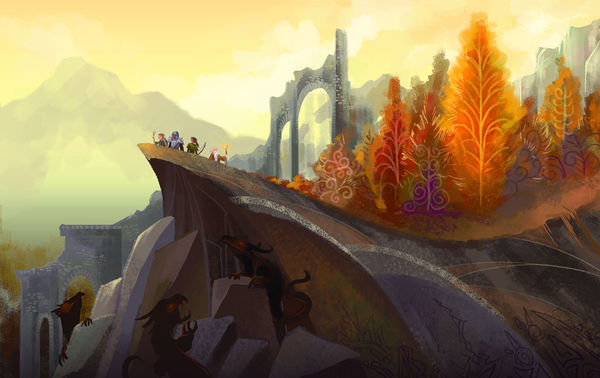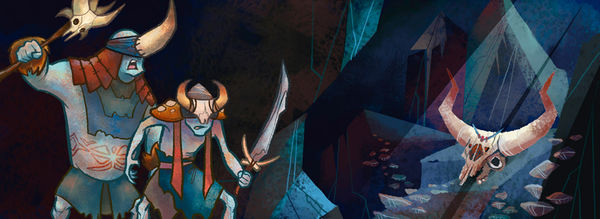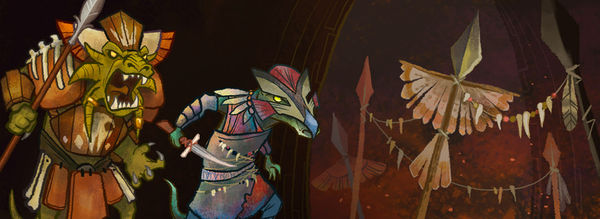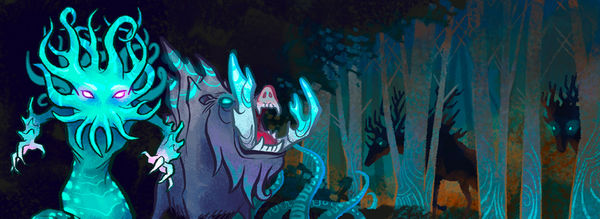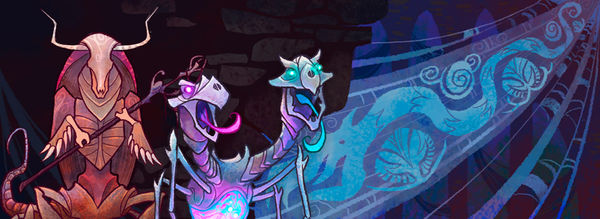Difference between revisions of "Writer's Guide"
(→Heroes) |
m (typo correction) |
||
| (42 intermediate revisions by 9 users not shown) | |||
| Line 1: | Line 1: | ||
All about writing for Wildermyth! | All about writing for Wildermyth! | ||
=Lore= | ==Lore== | ||
==The Yondering Lands== | ===The Yondering Lands=== | ||
[[File:YonderingLands.jpg|600px]] | |||
The world goes through [[loops|cycles]]. Civilizations rise and fall, and threats to humanity wax and wane. Building ruins, powerful artifacts, the memories of great deeds all fade into myth or are lost to memory and are rediscovered time and again. The history of the lands are repeated patterns that are still never quite the same. | |||
[[ | |||
[[ | [[The Yondering Lands]] are sort of vaguely American. Or at least, if you have a choice between American and European, lean American. This applies mainly to flora and fauna, but also to little things like, we don't talk a lot about nobility, kings and queens, and we don't use a lot of the strongly-flavored medieval-fantasy words. No British accents or isms, unless it's a particularly foreign character. (People have been known to fall into the lands from time to time from other places, so.) But then also, we don't quite do banjos and cowboy hats. Guitars are maybe right on the edge. Fiddles are probably cool, right? I don't know. | ||
===Monsters!=== | |||
[[ | [[File:MonsterBanner_deepist.jpg|600px]] | ||
[[Thrixl]] | [[Deepist]]s are a minotaur-worshiping cult who live in cave systems. They put stone and fungi to creative use, and our heroes aren't sure whether their power comes from their own passion, or from something more sinister... Read some in-fiction lore [[Deepist Lore|here]]. | ||
[[File:MonsterBanner_drauven.jpg|600px]] | |||
[[Drauven]] are grouchy lizard-folk who primarily live in the trees of forests and swamps, or in trees within swamps, but are happy to descend to the ground to go raid a village and maybe snack on a villager. They decorate themselves and their environment with bird and dragon-like motifs. Read some in-fiction lore [[Drauven Lore|here]]. | |||
[[File:MonsterBanner_gorgon.jpg|600px]] | |||
[[Gorgon]]s have been corrupting the local wildlife and turn them into raging tentacular monsters. They seem to be doing this experimentally, in pursuit of some deeper truth, but to call them "scientists" would tarnish the word. In the meantime, they continue to create the beasts as quickly as we can slaughter them. Read some in-fiction lore [[Gorgon Lore|here]]. | |||
[[File:MonsterBanner_morthagi.jpg|600px]] | |||
[[Morthagi]] are clockwork undead, created from bone and metal long ago to serve some dark master. Their creator may be long gone, but the Morthagi themselves have persisted, clanking and hissing in the dusty, forgotten corners of the world. Read some in-fiction lore [[Morthagi lore|here]]. | |||
[[File:MonsterBanner_thrixl.jpg|600px]] | |||
[[Thrixl]] are dreamlike insect-dragons. Their powers are more subtle than those of a Drauv, but more frightening. They prefer to attack minds and souls directly. Read some in-fiction lore [[Thrixl lore|here]]. | |||
All monsters are indeed monstrous. There may be shades of gray, but in aggregate monstrous life is incompatible with human life. Humans fight monsters to survive. | All monsters are indeed monstrous. There may be shades of gray, but in aggregate monstrous life is incompatible with human life. Humans fight monsters to survive. | ||
| Line 22: | Line 36: | ||
There are no demi-humanish creatures in the Yondering Lands: no elves, dwarves, orcs, or their kin. But I mean, we COULD have some badger-people or some other weird stuff. I mean, Drauven are kindof on the line, aren't they? But certainly none of the "stock fantasy races." | There are no demi-humanish creatures in the Yondering Lands: no elves, dwarves, orcs, or their kin. But I mean, we COULD have some badger-people or some other weird stuff. I mean, Drauven are kindof on the line, aren't they? But certainly none of the "stock fantasy races." | ||
==Magic!== | ===Magic!=== | ||
Human magic is performed by [[mystic]]s who [[interfuse]] with objects to manipulate them. | Human magic is performed by [[mystic]]s who [[interfuse]] with objects to manipulate them. | ||
But also, some [[monster]]s can perform magic and/or ARE magic. | But also, some [[monster]]s can perform magic and/or ARE magic. | ||
==Equipment!== | ===Equipment!=== | ||
There's lots of [[equipment]] in the game. Generally procedurally generated, but its history grows over time. Every piece of equipment has a description, some narrative insight that follows some [[Equipment Descriptions|general rules]]. | There's lots of [[equipment]] in the game. Generally procedurally generated, but its history grows over time. Every piece of equipment has a description, some narrative insight that follows some [[Equipment Descriptions|general rules]]. | ||
=How the Game Works= | TODO - The equipment design is in pretty heavy flux right now. | ||
==How the Game Works== | |||
This is a quick overview of how the game functions. It's good to have a handle on this so you know what you can do. | This is a quick overview of how the game functions. It's good to have a handle on this so you know what you can do. | ||
==Heroes== | ===Heroes=== | ||
[[Hero]]es are generated with [[History]], which drives [[ | [[Hero]]es are generated with [[History]], which drives [[Aspect]]s, which drive [[Stat]]s. | ||
Hero History is generated as three lines, an Origin, and Anecdote, and a Motivation. These affect prime stats and personality stats, and also seed Hooks. | |||
History lines leave behind a number of [[Hook]]s (usually 3 per hero), which are more specific character aspects and often take the form of a personality flaw or quirk. Hooks are great things to hang quests off of! They're also useful for letting a hero have a moment of badassery or weakness that's totally in theme for them. You can call out hooks when adding story roles, if you want to tell a whole story that hinges on one, or if you want to call out an optional character to provide an alternative path, that sort of thing. | |||
[[Aspect]]s are just facts about the hero. Stuff like "human", "female", "attractedToMen", "hunter", "missingLeftArm". Aspects can carry stat modifiers and [[Effect]]s. Aspects are the workhorse of the dynamic content in the game, almost everything you need to know about a hero, site, anything really, can be accessed as an aspect (other than stat values). (History lines cannot be queried, but can apply aspects, which can be queried.) Hooks are just aspects with a special naming convention and some extra tooling around them. | |||
[[Stat]]s are divided into Prime and Secondary, and into Gameplay and Personality. You can use any of the stats when selecting targets and determining difficulty rolls for events. Some stats have different natural ranges, which is a bit awkward, but that's where we're at right now. Personality stats are a great way to make characters come alive. | |||
[[File:Wildermyth Content.png|600px]] | |||
===Overland Map=== | |||
See: [[Campaign]] | |||
== | The overland map is randomly generated, and fits together like board game tiles. In between tiles, mountain ranges and rivers create barriers that restrict travel. Players explore one tile at a time, scouting the tile, fighting any lurking threats, and then defending and improving the tile over time. | ||
==Mission | |||
==Legacy and Unlockables== | About half of the tiles the player explores will have an enemy lair on them. Lairs must be cleared through combat. Attacking a lair triggers an ''Arrive at Site'' story. Empty tiles may trigger a ''Wilderness Scouting'' 'story. Monsters will occasionally attack tiles that the player controls. The player will be prompted to defend. | ||
==Effects: Triggers, Targets and Outcomes== | |||
Most things that happen in the game are modeled with Effects. Effects each have a trigger, a set of targets, and a set of branching outcomes. This same system is used for combat abilities and storytelling. | As play progresses through the [[chapter]]s , the player will gain access to more and more area, which means additional tiles will be accessible. Control of tiles is important to the player, because it provides benefits at the end of each chapter, and Tiles are a source of stories and advancement for characters as well. | ||
===Mission Maps=== | |||
[[Mission]]s take place on randomly generated maps. The way it works is there are a set of scripts, and each script builds one type of map, with some random variation. Mission maps are designed to break the encounter into 2-4 sections, so that the player has some control over the pace of the fight. | |||
===Legacy and Unlockables=== | |||
A player's [[Legacy]] is a collection of their favorite heroes, and these heroes can rejoin playthrough after playthrough. Similarly we track things the player has done over time as [[Unlockables]], which are also stored in the legacy. Stories should be able to query this stuff. | |||
===Effects: Triggers, Targets and Outcomes=== | |||
Most things that happen in the game are modeled with [[Effects]]. Effects each have a trigger, a set of targets, and a set of branching outcomes. This same system is used for combat abilities and storytelling. | |||
Stories use this system to specify when they can be told, and how they change the game world. | Stories use this system to specify when they can be told, and how they change the game world. | ||
See Main Article: [[Story Inputs and Outputs]] | See Main Article: [[Story Inputs and Outputs]] | ||
== | ==Tools== | ||
===Set up your work space=== | |||
If you are a developer and have version control access, you should also have access to the version control setup guide, which is not stored on this wiki since it contains some sensitive information. Do that setup first. | |||
* How to run [[Scratchpad]], | |||
* Some common [[Technical Difficulties]]. | |||
* Learn how to [[Testing|test]] your content. | |||
===Exploring Existing Content=== | |||
The fastest way to find the content is by using [[Scratchpad]], but a lot of it can be found in the game as well, if you have cheats turned on. The [[Character Sheet]] is home to a lot of this, and the [[Content Editor]] can be pulled up with F12 once you're in-game. | |||
[[Combat Lab]] is a great place to see what's currently possible in the game. From here, there a number of cheats accessible that will help you to build any character you want to try out. [[Gear]] upgrades, ability upgrades, and (some) narrative content can all be accessed here if you poke around. Particularly, check out the [[Character Sheet]]. | |||
[[Environment Lab]] will show you what mission maps we currently support. | |||
[[Name Lab]] gives you some insight into the name generator. | |||
[[The Content and Comics Editor]] is where the vast bulk of the content in the game is accessible. | |||
[[Character Lab]] is currently sorta broken, but wants to be a catalog of all the heroes and monsters we can generate. | |||
===Using The Editors=== | |||
See main article: [[Comic Editor Reference]] | |||
==Tone, Style, Voice, Visuals== | |||
* What's a good story? | |||
* What length should cut-scenes be? | |||
* What's our "bar" for comic panels? | |||
* How many personality-specific lines should there be? | |||
=Stretching and Establishing new Content= | Let's decide all this! | ||
==Stretching and Establishing new Content== | |||
How far can stories range from the existing material and game assets? Spoiler: quite far! | How far can stories range from the existing material and game assets? Spoiler: quite far! | ||
| Line 72: | Line 127: | ||
'''Comic Art''' is very cheap. If you need a prop or a background to tell a story properly, ask for it! | '''Comic Art''' is very cheap. If you need a prop or a background to tell a story properly, ask for it! | ||
'''Special Gear''' Weapons are maybe the second-cheapest asset class in the game, specify as many as you like. Augments are also pretty cheap. Armor is fairly expensive, but we can do it if it feels really special. | '''Special [[Gear]]''' Weapons are maybe the second-cheapest asset class in the game, specify as many as you like. Augments are also pretty cheap. Armor is fairly expensive, but we can do it if it feels really special. | ||
'''One-Off Monsters''' if none of the existing monsters make sense, you can call for a one-off monster to appear in a story or a fight. Most stories probably won't need this, but it's relatively inexpensive, so let's do it when it makes sense. | '''One-Off Monsters''' if none of the existing monsters make sense, you can call for a one-off monster to appear in a story or a fight. Most stories probably won't need this, but it's relatively inexpensive, so let's do it when it makes sense. | ||
| Line 92: | Line 147: | ||
'''Combat Avantages/Disadvantages''' are not totally implemented, so let us know what you want to see. | '''Combat Avantages/Disadvantages''' are not totally implemented, so let us know what you want to see. | ||
=Event Types= | ==Event Types== | ||
There are maybe 10 or 12 different types of randomly selected events that we need. They each cover a particular situation, have different inputs and outputs, and generally impose particular constraints on the writer. | |||
See main article: [[Event Types]]. | |||
[[Category:Modding]] | |||
[[Category:Writing]] | |||
Latest revision as of 22:58, 2 June 2023
All about writing for Wildermyth!
Lore
The Yondering Lands
The world goes through cycles. Civilizations rise and fall, and threats to humanity wax and wane. Building ruins, powerful artifacts, the memories of great deeds all fade into myth or are lost to memory and are rediscovered time and again. The history of the lands are repeated patterns that are still never quite the same.
The Yondering Lands are sort of vaguely American. Or at least, if you have a choice between American and European, lean American. This applies mainly to flora and fauna, but also to little things like, we don't talk a lot about nobility, kings and queens, and we don't use a lot of the strongly-flavored medieval-fantasy words. No British accents or isms, unless it's a particularly foreign character. (People have been known to fall into the lands from time to time from other places, so.) But then also, we don't quite do banjos and cowboy hats. Guitars are maybe right on the edge. Fiddles are probably cool, right? I don't know.
Monsters!
Deepists are a minotaur-worshiping cult who live in cave systems. They put stone and fungi to creative use, and our heroes aren't sure whether their power comes from their own passion, or from something more sinister... Read some in-fiction lore here.
Drauven are grouchy lizard-folk who primarily live in the trees of forests and swamps, or in trees within swamps, but are happy to descend to the ground to go raid a village and maybe snack on a villager. They decorate themselves and their environment with bird and dragon-like motifs. Read some in-fiction lore here.
Gorgons have been corrupting the local wildlife and turn them into raging tentacular monsters. They seem to be doing this experimentally, in pursuit of some deeper truth, but to call them "scientists" would tarnish the word. In the meantime, they continue to create the beasts as quickly as we can slaughter them. Read some in-fiction lore here.
Morthagi are clockwork undead, created from bone and metal long ago to serve some dark master. Their creator may be long gone, but the Morthagi themselves have persisted, clanking and hissing in the dusty, forgotten corners of the world. Read some in-fiction lore here.
Thrixl are dreamlike insect-dragons. Their powers are more subtle than those of a Drauv, but more frightening. They prefer to attack minds and souls directly. Read some in-fiction lore here.
All monsters are indeed monstrous. There may be shades of gray, but in aggregate monstrous life is incompatible with human life. Humans fight monsters to survive.
There are no demi-humanish creatures in the Yondering Lands: no elves, dwarves, orcs, or their kin. But I mean, we COULD have some badger-people or some other weird stuff. I mean, Drauven are kindof on the line, aren't they? But certainly none of the "stock fantasy races."
Magic!
Human magic is performed by mystics who interfuse with objects to manipulate them.
But also, some monsters can perform magic and/or ARE magic.
Equipment!
There's lots of equipment in the game. Generally procedurally generated, but its history grows over time. Every piece of equipment has a description, some narrative insight that follows some general rules.
TODO - The equipment design is in pretty heavy flux right now.
How the Game Works
This is a quick overview of how the game functions. It's good to have a handle on this so you know what you can do.
Heroes
Heroes are generated with History, which drives Aspects, which drive Stats.
Hero History is generated as three lines, an Origin, and Anecdote, and a Motivation. These affect prime stats and personality stats, and also seed Hooks.
History lines leave behind a number of Hooks (usually 3 per hero), which are more specific character aspects and often take the form of a personality flaw or quirk. Hooks are great things to hang quests off of! They're also useful for letting a hero have a moment of badassery or weakness that's totally in theme for them. You can call out hooks when adding story roles, if you want to tell a whole story that hinges on one, or if you want to call out an optional character to provide an alternative path, that sort of thing.
Aspects are just facts about the hero. Stuff like "human", "female", "attractedToMen", "hunter", "missingLeftArm". Aspects can carry stat modifiers and Effects. Aspects are the workhorse of the dynamic content in the game, almost everything you need to know about a hero, site, anything really, can be accessed as an aspect (other than stat values). (History lines cannot be queried, but can apply aspects, which can be queried.) Hooks are just aspects with a special naming convention and some extra tooling around them.
Stats are divided into Prime and Secondary, and into Gameplay and Personality. You can use any of the stats when selecting targets and determining difficulty rolls for events. Some stats have different natural ranges, which is a bit awkward, but that's where we're at right now. Personality stats are a great way to make characters come alive.
Overland Map
See: Campaign
The overland map is randomly generated, and fits together like board game tiles. In between tiles, mountain ranges and rivers create barriers that restrict travel. Players explore one tile at a time, scouting the tile, fighting any lurking threats, and then defending and improving the tile over time.
About half of the tiles the player explores will have an enemy lair on them. Lairs must be cleared through combat. Attacking a lair triggers an Arrive at Site story. Empty tiles may trigger a Wilderness Scouting 'story. Monsters will occasionally attack tiles that the player controls. The player will be prompted to defend.
As play progresses through the chapters , the player will gain access to more and more area, which means additional tiles will be accessible. Control of tiles is important to the player, because it provides benefits at the end of each chapter, and Tiles are a source of stories and advancement for characters as well.
Mission Maps
Missions take place on randomly generated maps. The way it works is there are a set of scripts, and each script builds one type of map, with some random variation. Mission maps are designed to break the encounter into 2-4 sections, so that the player has some control over the pace of the fight.
Legacy and Unlockables
A player's Legacy is a collection of their favorite heroes, and these heroes can rejoin playthrough after playthrough. Similarly we track things the player has done over time as Unlockables, which are also stored in the legacy. Stories should be able to query this stuff.
Effects: Triggers, Targets and Outcomes
Most things that happen in the game are modeled with Effects. Effects each have a trigger, a set of targets, and a set of branching outcomes. This same system is used for combat abilities and storytelling.
Stories use this system to specify when they can be told, and how they change the game world.
See Main Article: Story Inputs and Outputs
Tools
Set up your work space
If you are a developer and have version control access, you should also have access to the version control setup guide, which is not stored on this wiki since it contains some sensitive information. Do that setup first.
- How to run Scratchpad,
- Some common Technical Difficulties.
- Learn how to test your content.
Exploring Existing Content
The fastest way to find the content is by using Scratchpad, but a lot of it can be found in the game as well, if you have cheats turned on. The Character Sheet is home to a lot of this, and the Content Editor can be pulled up with F12 once you're in-game.
Combat Lab is a great place to see what's currently possible in the game. From here, there a number of cheats accessible that will help you to build any character you want to try out. Gear upgrades, ability upgrades, and (some) narrative content can all be accessed here if you poke around. Particularly, check out the Character Sheet.
Environment Lab will show you what mission maps we currently support.
Name Lab gives you some insight into the name generator.
The Content and Comics Editor is where the vast bulk of the content in the game is accessible.
Character Lab is currently sorta broken, but wants to be a catalog of all the heroes and monsters we can generate.
Using The Editors
See main article: Comic Editor Reference
Tone, Style, Voice, Visuals
- What's a good story?
- What length should cut-scenes be?
- What's our "bar" for comic panels?
- How many personality-specific lines should there be?
Let's decide all this!
Stretching and Establishing new Content
How far can stories range from the existing material and game assets? Spoiler: quite far!
Because we are using 2D art and no animation, certain things are incredibly cheap for us to do, which would be prohibitively expensive for other games. Here are some examples which should give you an idea. In general, we are looking for writing to stretch and grow our content range as much as possible.
Here are few but if you have a particular idea, run it past!
Comic Art is very cheap. If you need a prop or a background to tell a story properly, ask for it!
Special Gear Weapons are maybe the second-cheapest asset class in the game, specify as many as you like. Augments are also pretty cheap. Armor is fairly expensive, but we can do it if it feels really special.
One-Off Monsters if none of the existing monsters make sense, you can call for a one-off monster to appear in a story or a fight. Most stories probably won't need this, but it's relatively inexpensive, so let's do it when it makes sense.
Body Modifications are where our character rig really shines. Any limb, or the head, can be swapped out for something monstrous or more awesome. Hair styles, skin patterns, scars, tattoos, bring it! It gets a little tricky if it modifies the face, because the different facial expressions
Playable Characters might be monsters or weirdthings that you can recruit or get transformed into. Fairly cheap, and we really want these. One thing to consider is whether they will be able to use weapons or armor. The default approach is that non-humans don't use gear, but we could possibly make an exception for weapon-wielding, since that is relatively easy to rig up.
In-game Scenery is cheap, and could double as comic props?
Map icons are very cheap if you need something specific.
In-Game Environments are expensive, since they require a lot of art to work together, and a deal of programming too. But, bring your ideas. We might be able to make something work.
Combat Abilities Do you need special abilities, as rewards, for one-off enemies, playable characters, or whatever? They are pretty easy to make! Say what you want and we can talk it over.
Buffs/Debuffs are relatively cheap, particularly if they are similar to an existing effect.
Combat Avantages/Disadvantages are not totally implemented, so let us know what you want to see.
Event Types
There are maybe 10 or 12 different types of randomly selected events that we need. They each cover a particular situation, have different inputs and outputs, and generally impose particular constraints on the writer.
See main article: Event Types.
